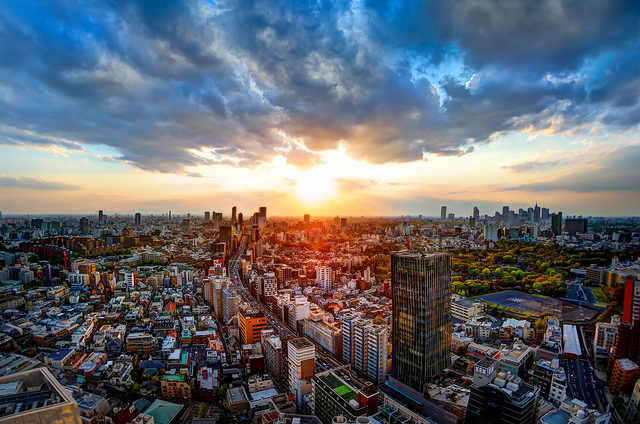Physical Address
304 North Cardinal St.
Dorchester Center, MA 02124
Physical Address
304 North Cardinal St.
Dorchester Center, MA 02124

Sandy Ikeda has led a Brooklyn Heights Jane’s Walk every year since 2011 in celebration of Jane Jacobs’ 101st birthday. Meet at the steps of Borough Hall (facing the Plaza and fountain) Sunday May 7th at 12:15. When you think of a city you like, what comes to mind? Can a city be a work of art? How do parked cars serve pedestrians? Most of the interaction among people, bikes, and cars is unplanned. How does that happen? Why do people gather in some places and avoid others? Is it possible to create a neighborhood from the ground up? What is a “public space”? How can the design of public space promote or retard social interaction? The beautiful and historic neighborhood of Brooklyn Heights offers excellent examples of Jane Jacobs’s principles of urban diversity in action. Beginning at the steps of Brooklyn¹s Borough Hall, we will stroll through residential and commercial streets while observing and talking about how the physical environment influences social activity and even economic and cultural development, both for good and for ill. We will be stopping at several points of interest, including the famous Promenade, and end near the #2/3 subway and a nice coffeehouse. To Find a Jane’s Walk near you, visit http://janeswalk.org/

1. Announcements: Get ready for Market Urbanism at #FEEcon June 15-17 in Atlanta. Market Urbanists can use the code MU40OFF to get 40% off. We’ll have several other exciting announcements over the next few days. We can’t wait to see you there! If you are in New York, Market Urbanism is pleased to be a partner of Smart Cities NYC ’17: Powered by People, May 3-6. (smartcitiesnyc.com). The offer code SCNYC100 gets market urbanists a $100 ticket discounted down from the $1,200 standard price. Sandy Ikeda has a short clip in the film Citizen Jane: Battle for the City. Go see it!! Sandy Ikeda‘s Annual Jane’s Walk in Brooklyn Heights is this Sunday at 12:15. Vince Graham, former Chairman of the South Carolina Transportation Infrastructure Bank and friend of Market Urbanism published an op-ed in the Charleston Post and Courier: Unhealthy S.C. appetite for roads demands a diet 2. Recently at Market Urbanism: Market Urbanist Book Review: Cities and The Wealth of Nations by Jane Jacobs by Matthew Robare It seems like just about everyone who has ever set foot in a major city has read The Death and Life of Great American Cities and most professional urban planners have embraced at least part of her ideas. But that was not the only book she wrote and the others deserve attention from urbanists. Government-Created Parking Externalities by Emily Hamilton Developers are not responsible for creating a traffic congestion externality. Rather, city policymakers create this externality when they provide free or underpriced street parking. They cause drivers to waste time and gas sitting in traffic. Parking is not a public good that needs to be publicly-provided; it’s both rivalrous and excludable. Richard Florida and Market Urbanism by Michael Lewyn Florida writes that part of this “crisis” is the exploding cost of housing in some […]

I just finished reading Richard Florida’s new book, The New Urban Crisis. Florida writes that part of this “crisis” is the exploding cost of housing in some prosperous cities. Does that make him a market urbanist? Yes, and no. On the one hand, Florida criticizes existing zoning laws and the NIMBYs who support them. He suggests that these policies not only raise housing prices, but by doing so harm the economy as a whole. For example, he writes that if “everyone who wanted to work in San Francisco could afford to live there, the city would see a 500 percent increase in jobs… On a national basis, [similar results] would add up to an annual wage increase of $8775 for the average worker, adding 13.5 percent to America’s GNP – a total gain of nearly $2 trillion” (p 27). On the other hand, Florida is not ready to endorse the idea that “we can make our cities more affordable… simply by getting rid of existing land use restrictions” because “the high cost of land in superstar neighborhoods makes it very hard if not impossible, for the private market to create affordable housing in their vicinity. Combine the high costs of land with the high costs of high-rise construction and the result is more high-end luxury housing.” (p. 28). I don’t find his point persuasive, for a variety of reasons. First, as I have written elsewhere, land prices are often quite volatile. Second, the overwhelming majority of any region’s housing is not particularly new; even in high-growth Houston, only 2 percent of housing units were built after 2010. Thus, new market-rate housing is likely to affect rents by affecting the price of older housing, rather than by bringing new cheap units into the market. Florida also writes that “too much density can […]
In new research on parking policy in the Journal of Economic Geography, Jan Brueckner and Sofia Franco argue that residential developers should be required to provide more off-street parking in places where street parking contributes to traffic congestion. They argue that because traffic congestion is a negative externality, off-street parking requirements improve urban living. But street parking only contributes to traffic congestion when policymakers underprice it. Rather than addressing the externality of a government-created problem with new regulations, cities should price their street parking appropriately. Brueckner and Franco’s argument relies on the assumption that off-street parking will be under-provided without government intervention. They argue that because drivers circle their destination looking for free or cheap street parking, minimum parking requirements make people better off. The authors are correct in arguing that street parking contributes to the problem of traffic congestions. Parking guru Donald Shoup estimates that drivers who are circling around looking for parking spots make up 30 percent of downtown traffic. Cruising for parking imposes an external cost on others by causing everyone to waste time in slow traffic. While, Brueckner and Franco actually cite Shoup’s work on street parking and traffic congestion, they ignore his insight that when parking is priced appropriately, cities can eliminate this externality. The incentive to cruise for parking originates with public policy when city officials provide street parking at below-market prices. When parking prices are high enough, drivers will leave some parking availability on each block, eliminating the cruising problem without the need for minimum parking requirements. San Francisco’s SFPark program provides an example of successful implementation of variable pricing based on demand. SFPark has the goal of maintaining one to two available spots on each block so that drivers don’t contribute to traffic congestion while they’re looking for parking. When street parking is priced high […]

No one writer of the last 60 years has influenced urban planning and thinking as much as Jane Jacobs. It seems like just about everyone who has ever set foot in a major city has read The Death and Life of Great American Cities and most professional urban planners have embraced at least part of her ideas. But that was not the only book she wrote and the others deserve attention from urbanists. First published in 1984, Cities and the Wealth of Nations was her last book to focus on cities and her second concerned with economics. Conceived at the height of 1970s stagflation, Jacobs brought her considerable polemical skills to bear on macroeconomics and elaborated on the observations in The Economy of Cities. In that book she theorized that economic expansion in cities was driven by trade, innovation and imitation in a process she called “import replacement”. In this one she extended the idea, arguing that cities and not nation-states are the real basic units of macroeconomic life. She also examined how the economic expansion affected regions in differing geographic proximity and how import-replacement and the wealth generated by it can be used in ways that ultimately undermine the abilities of cities to create wealth, which she called transactions of decline. Import-replacement is one of Jacobs’ more controversial ideas, partially because it seems similar to a discredited development policy called import substitution and partially because her evidence is largely anecdotal, as Alon Levy wrote back in 2007. Nevertheless it’s the centerpiece of Jacobs’ economic theories. And dismissing her work based on a lack of conventional credentials ignores her entire rise to fame and influence. Two important things distinguish import-replacement from import-substitution. Substitution is a national policy pursued by governments with taxes, tariffs and subsidies while replacement is a process […]

1. Announcements John Morris has started an alternative Facebook group called Flyover Urbanism: A Market Urbanist Group for Flyover Country 2. This Week at Market Urbanism Emily Hamilton Market Urbanism is Still underrated New data keeps coming in that shows that increases in housing supply tend to be followed by declining rental rates, even in the cities facing the highest demand. Nolan Gray Towards A Liberal Approach To Urban Form A liberal approach to urban form accepts that reasonable people can disagree over the ideal urban arrangement. Wrapped into every grand vision and design regulation are particular normative preferences that many may not share. Should retail and residential be separate? Should every apartment receive at least one hour of direct sunlight? Should everyone live on a one acre lot? Jeff Fong Building A Better BART BART owns acres of surface parking spread out across the system. If it were to redevelop these parking lots into high density, mixed use developments, it could copy the MTRC model and create a high yield stream of revenue. Sandy Ikeda The Other Broken Window Whether you quickly mend a broken window, bend over to pick up a piece of trash, or intervene when someone disturbs the peace depends in part on your personal ethics, of course. But it also depends very much on whether your neighbors will applaud or laugh at you for doing it. 3. Where’s Scott? Scott Beyer remains in Portland, and this weekend will visit Eugene and Corvallis. His Forbes article this week was Portland’s Urban Growth Boundary: A Driver of Suburban Sprawl If bustling cities prevent what can be vaguely defined as “sprawl” on their nearest virgin land, it’s not like the people will go away and the sprawl will stop. It may resurface in even more remote places. This is counterproductive both for [density] advocates, and […]

In 2016, voters in San Francisco, Alameda and Contra Costa county approved a $3.5 Billion dollar bond to keep BART moving. Funds from the bond will be used to replace aging infrastructure throughout the system, but even three and half billion dollars will scarcely keep us running in place. Maintaining what we have long term—and eventually improving on what’s already in place—means finding a sustainable revenue stream for the system and reimagining how we fund transit in the Bay Area. Hong Kong vs the Bay Putting BART on permanently firm financial footing doesn’t mean reinventing the wheel. Commuter rail systems in East Asia figured out how to run profitably decades ago. And there’s no better example of what BART could be than the Metro Transit Railway Corporation (MTRC) in Hong Kong. The MTRC operates 130 miles of track (roughly equivalent to BART). It transports over 5 million passengers a day (about 10x BART’s daily ridership). And it posts a 99.9% on time rate (let’s just say…way the hell better than BART). MTRC System Map The MTRC is able to maintain its first-in-class service levels because it doesn’t skimp on the upkeep. It employs approximately 5,000 technicians who physically inspect every inch of track once every three days. The rolling stock is given a similar level of attention. And the entire system is overseen from a state-of-the-art control center where management can identify problems in real-time. The result of all this preventative care is a transit system that reliably performs at scale and sets the global standard for commuter rail. All told, the MTRC spends an impressive US $700 million a year on maintenance and improvements. But perhaps the most amazing thing is that this $700 million comes out to less than 40% of the MTRC’s yearly revenue. Value Capture Finance […]

It is because every individual knows little and, in particular, because we rarely know which of us knows best that we trust the independent and competitive efforts of many to induce the emergence of what we shall want when we see it. — Friedrich Hayek, The Constitution of Liberty Imagine the perfect city. If you have a clear picture in mind, you’re not alone. Tsars, emperors, and prophets have been trying to build perfect cities for millennia. With the emergence of the field of urban planning and modern social science, everyone from stenographers to industrialists to independent architects have joined in. For Ebenezer Howard, the perfect city was the Garden City, a corporate-owned residential satellite on the outer edge of town. For Le Corbusier, it was the Ville Radieuse, full of “skyscrapers in the park” and elevated highways. For Frank Lloyd Wright, it was Broadacre City, a dispersed anti-city full of single-family homes on one-acre lots. Each reflects a distinct vision of urban life, and each seems to have as many opponents as it does proponents. Thankfully, few of these plans have ever been implemented in full on a mass scale. Yet “perfect city” thinking—the view that one particular vision of urban form should be imposed by planners—has manifested itself in small ways in cities around the world through the construction and enforcement of specific theories of how a city should work. This approach to urban form involves expanding urban planning beyond prudentially managing infrastructure and mitigating destructive negative externalities and toward enforcing and preserving particular lifestyle and aesthetic preferences. Consider: while Ville Radieuse was never built, many cities bulldozed traditional urban neighborhoods to construct the urban elevated highways of Le Corbusier’s dreams. While Broadacre City never moved beyond the model stage, many suburban communities still zone minimum lot sizes […]

My first article for TheFreemanOnline dealt with the “broken window fallacy.” But in the literature on social theory, there’s actually another important idea that also uses the metaphor of a “broken window.” In his comment on The Freeman’s Facebook page, Flavio Ortigao raised this point when he wrote: …I do not quite follow the putative analogy with broken windows theory. In many case[s] “broken windows” has been used as an analogy for the necessity of not allowing the degradation of public space/utilities. Inferring that there is a psychological effect that compounds the problem. I think [it] is very important that cities do not surrender to vandalism. This has little to do with the situation of Haiti, struck by a natural disaster. Mr. Ortigao is right. The idea to which he refers does not directly relate to the Haitian earthquake or to other situations in which destruction is supposed to create wealth. That’s a different “broken window.” The typical way to commit the broken-window fallacy is to argue that a natural disaster, war, or economic crisis is actually good for an economy. The idea is that if the event causes an increase in spending on infrastructure or war materiel or what-have-you, the “new” demand will stimulate the economy and create more wealth than there would have been otherwise. But that’s not what Mr. Ortigao is referring to. One of the articles I assign to my students is George L. Kelling and James Q. Wilson’s “Broken Windows” (1982) in which they say: “…one unrepaired broken window is a signal that no one cares, and so breaking more windows costs nothing.” This would also apply to trash left on the sidewalk or drunks sleeping on benches, that sort of thing. And because “disorder and crimes are inextricably linked,” a community that tolerates minor […]
New data keeps coming in that shows that increases in housing supply tend to be followed by declining rental rates, even in the cities facing the highest demand. After a boom year for apartment construction in 2016, rents are falling in New York City, San Francisco, and Washington, DC. Median rents for one-bedrooms across New York City fell by 9.1% in the past year. Even in San Francisco — the most productive city in the country — a burst of new supply in 2016 has led to falling rents. Estimates put rent year-over-year decline in prices at 1% to 9%. Rising vacancy rates and quarter-over-quarter declines in Seattle’s rental rates are a sign that it’s leaving a period of double-digit annual increases. A decade of increasing construction rates in DC has leveled off rent prices. Los Angeles has not seen the apartment boom that has benefitted renters in other expensive cities, and its rental rates are the fastest rising in California. Scott points out the striking correlation between housing construction and house prices in in-demand cities. This trend of declining rents is some very preliminary evidence against Tyler Cowen’s claim that densification in expensive cities will result in economic growth, but not falling rents as more buildings draw in more business activity and talent. A New York developer echoes Tyler’s view: “There are so many units, but then they all get eaten up. That is the way New York works.”